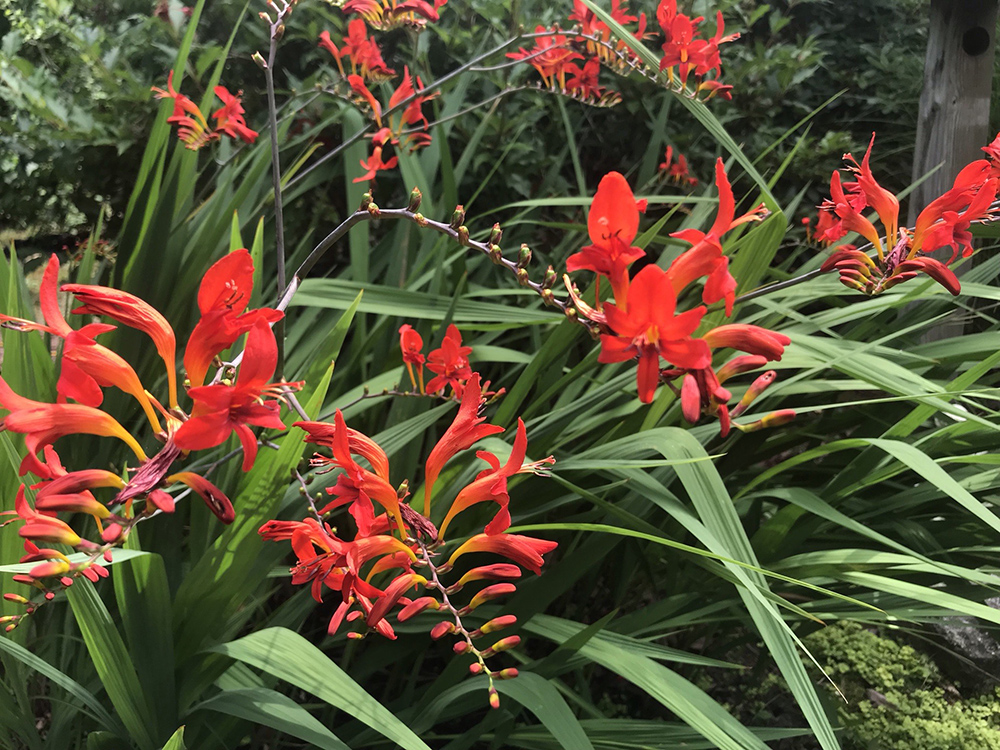Let It Grow
By Tammy Thornton
As July roars ahead, packing a punch with hot, sun-drenched days in its wake, the garden takes on a new look. Now the extroverted guests boldly join the garden party as trumpet vine, rose-of-Sharon, coneflower, vitex, phlox, and bee balm burst open with a dazzling summer display. Then suddenly, the power couple of good and evil, Crocosmia ‘Lucifer’ and Angel’s trumpet, brazenly waltz into the scene, creating quite a stir.
Lucifer boasts sword-like leaves and arching stems with fiery-red blooms. Hummingbirds and other pollinators will crave these tubular, vibrant flowers. Crocosmia, derives its name from two Greek words meaning saffron and odor because, when steeped in water, the dried flowers are said to give off a saffron-like scent. Also known as montbretia or coppertips, crocosmia can be red, orange, or yellow. Once established, these showy perennials that grow one to two feet are relatively carefree. They can be started from corms planted in the spring or divided from existing plants. Crocosmia will bloom best in full sun and will thrive in moist but well-drained soil. Once they have finished blooming, you can cut the stems, but keep the foliage until it turns yellow and dies back, as this will give energy back to the corms for the following year’s flowers. In our Shore Local area, corms can be left in the ground to overwinter, but mulch will give them an extra layer of protection.
Angel’s trumpet (Brugmansia) is a tropical plant that cannot take cold temperatures much below 50 degrees. But their amazing flowers and scent may entice you to plant them in your garden and find space to overwinter them indoors. In frost-free areas, they can be grown as perennials, reaching heights of twenty feet. The large, exotic trumpet-shaped flowers hang down and send an intoxicating scent through the air. In the evening, their fragrance is stronger, attracting nighttime pollinators. Angel’s trumpet blooms best in full sun and, like its counterpart, Lucifer, prefers moist but well-drained soil. But don’t let the name of this beautiful plant fool you. All parts of this plant are highly toxic! Use extreme caution if you have curious children or pets nearby.

Because Angel’s trumpet will succumb to cold weather, you must bring it indoors before the first frost in the fall. If your plant is fairly small, you could dig it up and pot it as a houseplant. Another, more manageable, method would be to take cuttings. This method will work both for overwintering or for propagating new plants. Your cuttings can be rooted in soil or in water. Because of its toxicity, a second warning is in order. Keep pets and children away from this plant. When I was first introduced to Angel’s trumpet, a fellow gardener gave me cuttings in the fall. At the time, rooting them in water was most practical for me, and they stayed in their vase all winter (though I did change the water frequently). What a treat to grow these fast-growing tropicals once the weather was warm. After they were fertilized, they produced the most magnificent flowers.
If this description of Angel’s trumpet sounds different than what you are familiar with, it’s possible that you are thinking of datura. The common name Angel’s trumpet is often used interchangeably for the two different plants, but ironically, datura is also known as devil’s trumpet, hell’s bells, and Jimsonweed. Like Brugmansia, all parts of datura are highly toxic. Datura also has highly fragrant, large trumpet-like flowers. However, datura produces flowers (often white or purple and white) that are erect and bloom in the evening, while Brugmansias are pendulous. Because datura blooms at night, it is pollinated by nocturnal insects such as the hawk moth. Though datura is an annual plant, it often reseeds from its spiky-ball seed pods.
Whether you decide to plant crocosmia, Brugmansia, or datura (or all three), you will, no doubt, be smitten by their exotic flowers. Meanwhile, you’ll be attracting both daytime and nighttime pollinators to your garden. Just use caution handling these dangerous beauties, especially indoors where curious children or pets could gain access to them. Do your homework to learn about these plants, because as we know, the devil is in the details.
We would love to hear about your experiences with these angelic and devilish plants. Send your comments, pictures, and questions to: shorelocalgardener@gmail.com.
Tammy Thornton lives with her husband, children, and crazy pets while enjoying a life of gardening, cooking, and going to the beach.










